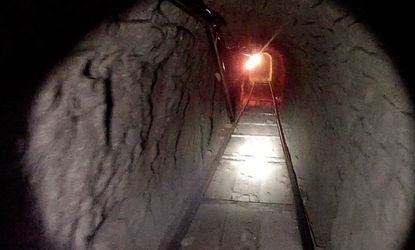A Mexican drug cartel's rise to dominance
The Sinaloa cartel is now the world's biggest supplier of illegal narcotics. How did it become so powerful?

What is the Sinaloa cartel?
The Mexican crime syndicate is the world's most powerful drug trafficking organization, and the biggest supplier of illegal narcotics in the U.S. About half of the estimated $65 billion worth of cocaine, heroin, and other illegal drugs that American users buy each year enters the U.S. via Mexico. Sinaloa — which is named after its home state in western Mexico — controls more than half of that cross-border trade, from which it earns at least $3 billion a year. U.S. law--enforcement officials say the group has a presence in all major American cities, and a near monopoly on the wholesale distribution of heroin and cocaine in Chicago. The city's Crime Commission has branded Sinaloa's elusive leader, Joaquín Guzmán, also known as El Chapo (or Shorty), Public Enemy No. 1 — a title last held by Al Capone. "What Al Capone was to beer and whiskey," said commission member Arthur Bilek, "Guzmán is to narcotics."
How did the cartel get started?
Subscribe to The Week
Escape your echo chamber. Get the facts behind the news, plus analysis from multiple perspectives.

Sign up for The Week's Free Newsletters
From our morning news briefing to a weekly Good News Newsletter, get the best of The Week delivered directly to your inbox.
From our morning news briefing to a weekly Good News Newsletter, get the best of The Week delivered directly to your inbox.
Mexican smugglers have long trafficked homegrown heroin and marijuana to the U.S. But in the 1980s, Mexico also became the primary route for Colombian cocaine bound for the U.S. At the time, U.S. law enforcement was cracking down on the Colombian drug producers' attempts to ship the lucrative drug into Florida by boats and planes. So the Colombians hired Mexico's Guadalajara cartel to smuggle drugs across the border, and paid them in cocaine, which allowed the Mexicans to build their own drug networks in the U.S. Before long, the Mexicans were the senior partners in the relationship. When Guadalajara's leader was arrested in 1989, the group's remaining capos, including a young Guzmán, divided up its trafficking routes, creating the Sinaloa, Juárez, and Tijuana cartels. These gangs soon became locked in a series of turf wars that have killed more than 60,000 people. But throughout the bloodshed, El Chapo's organization has continued to grow.
Why has Sinaloa succeeded?
The 5-foot-6 Guzmán may be a grade school dropout, but he's also "a logistical genius," said Jack Riley, the head of the Drug Enforcement Administration's Chicago division. He's trafficked cocaine from Colombia to Mexico in small private planes, in the luggage of airline passengers, and on the cartel's own 747s. Sinaloa has also moved cocaine on custom-built $1 million submarines. El Chapo, 56, has shown similar ingenuity moving drugs from Mexico to the U.S. He's built scores of tunnels under the border, some of which are air-conditioned and boast half-mile-long trolley lines. He's sent drugs through U.S. checkpoints in hidden car compartments, in cans of jalapeños, and in the bellies of frozen shark carcasses. Once in the U.S., the drugs are ferried to warehouses in Chicago — which Guzmán has called his "home port" — before being divided up and distributed across the nation.
Why Chicago?
Sign up for Today's Best Articles in your inbox
A free daily email with the biggest news stories of the day – and the best features from TheWeek.com
It's the transportation hub of America. The city is located within a day's drive of 70 percent of the nation's population, and is crisscrossed by major interstate highways and railway lines. Chicago is also a huge drug market in its own right. Some 86 percent of people arrested in Cook County in 2012 tested positive for at least one illegal narcotic — the highest percentage of any big U.S. city. With his monopoly in the city, Guzmán doubled wholesale heroin prices, thus cutting profit margins for street dealers. That fueled greater competition for turf and exacerbated Chicago's epidemic of gang violence. "It used to be honor among thieves," said Harold Ward, a former gang member turned anti-violence campaigner. "Now, it's by any means necessary."
How violent is the cartel?
Sinaloa can be exceedingly brutal — it left 14 severed heads in iceboxes outside a mayor's office in the northern Mexican city of Nuevo Laredo in 2012. But compared with other cartel leaders, El Chapo is a practical businessman who prefers "bribe over bullet." He invests millions in corrupting police and government officials in Mexico rather than intimidating them with violence. "There is a level-headedness about [Sinaloa's] leadership that the other groups lack," said Malcolm Beith, author of a book on Guzmán titled The Last Narco. Some observers claim that this fact has led both Mexican and U.S. authorities to go easy on Sinaloa.
Is that allegation true?
A 2010 National Public Radio investigation of Mexican arrest records noted that Sinaloa had suffered notably fewer arrests than other cartels. U.S. court documents also show that top Sinaloa officials regularly met with DEA agents between 2006 and 2012 and fed them intelligence about rival cartels, helping law enforcement crush their competitors. U.S. and Mexican officials have denied showing any favoritism toward Sinaloa, and the DEA has arrested several high-ranking cartel members in recent years, including Jesús Vicente Zambada Niebla, the son of the organization's No. 2 leader, Ismael Zambada. In a rare 2010 interview, the senior Zambada said that such arrests had no effect on the cartel, and that its drugs would keep flowing north even if El Chapo were brought down. "When it comes to the capos, jailed, dead, or extradited," he said, "their replacements are ready."
El Chapo's great escape
In 1993, Guzmán was captured and sentenced to 20 years for conspiracy, bribery, and drug trafficking. But even after he was sent to Mexico's maximum security Puente Grande prison, he continued to run his empire and live a life of luxury. With most of the prison officials on his payroll, he ordered meals from a menu, organized drug deals on cellphones, and had prostitutes, his wife, and several lovers brought in on prison trucks, as well as a supply of Viagra. Then in January 2001, El Chapo tired of being locked up, and was reportedly wheeled out of the prison inside a laundry cart. Many Mexicans believe prison officials in fact let the drug lord walk out. What actually happened may never be known, as security camera footage from that night disappeared, and records of vehicles entering and leaving the jail were erased.
Create an account with the same email registered to your subscription to unlock access.
Theunis Bates is a senior editor at The Week's print edition. He has previously worked for Time, Fast Company, AOL News and Playboy.
-
 Today's political cartoons - April 13, 2024
Today's political cartoons - April 13, 2024Cartoons Saturday's cartoons - moderate MAGA, automotive politics, and more
By The Week US Published
-
 5 Grand Canyon-size cartoons on the Arizona abortion ruling
5 Grand Canyon-size cartoons on the Arizona abortion rulingCartoons Artists take on a chasm in reproductive freedom, the dangers of an abortion ban, and more
By The Week US Published
-
 Crossword: April 13, 2024
Crossword: April 13, 2024The Week's daily crossword
By The Week Staff Published